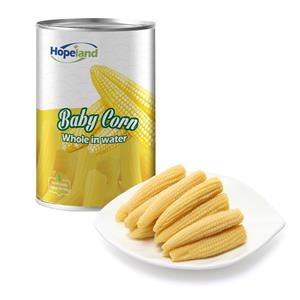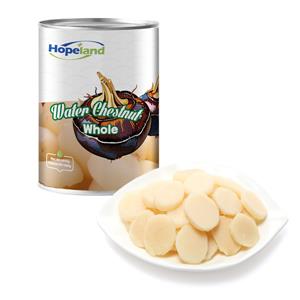Baby Corn-The Golden Elves on the Dining Table
Canned baby corn, often overlooked in the canned vegetable aisle, is a versatile and nutritious ingredient that deserves more attention. These miniature, tender ears of corn are harvested early, giving them a delicate texture and mildly sweet flavor. Whether you're a busy home cook, a health-conscious eater, or an adventurous foodie, canned baby corn can be a game-changer in your kitchen.
In this comprehensive guide, we’ll explore:
What is canned baby corn, and how is it made?
Nutritional benefits and health advantages
Creative ways to use canned baby corn in everyday cooking
How it compares to fresh and frozen baby corn
Tips for selecting the best canned baby corn
By the end, you’ll see why this humble canned vegetable should have a permanent spot in your pantry!
What Is Canned Baby Corn?
Baby corn (also known as corn shoots or young corn) is the immature ear of a corn plant, harvested before the kernels fully develop. Unlike mature corn, baby corn is small, tender, and entirely edible—including the cob.

How Is It Canned?
The canning process preserves baby corn at peak freshness:
Harvesting – Picked when just 2-4 inches long, ensuring tenderness.
Cleaning & Trimming – Husks and silks are removed, and the corn is washed.
Blanching – Briefly boiled to retain texture and color.
Packing & Canning – Sealed in water, brine, or a light preservative solution.
Sterilization – Heated to kill bacteria, ensuring long shelf life.
The result? A shelf-stable, ready-to-use vegetable that maintains its crunch and subtle sweetness.
Nutritional Benefits of Canned Baby Corn
Despite its small size, baby corn packs a surprising nutritional punch. Here’s why it’s a healthy choice:
1. Low in Calories, High in Fiber
Only about 25 calories per 100g – Great for weight management.
Rich in dietary fiber – Aids digestion and promotes gut health.
2. Vitamins & Minerals
Vitamin B6 & Folate – Supports metabolism and red blood cell production.
Vitamin C – Boosts immunity and skin health.
Potassium – Helps regulate blood pressure.
Magnesium & Iron – Important for muscle function and oxygen transport.
3. Low Glycemic Index (GI)
Unlike mature corn, baby corn has minimal starch, making it a diabetes-friendly option that doesn’t spike blood sugar.
4. Gluten-Free & Vegan
A safe choice for those with gluten intolerance or plant-based diets.
Note: While canned baby corn is nutritious, some brands may contain added salt. Opt for low-sodium or no-salt-added versions if watching sodium intake.
How to Use Canned Baby Corn in Cooking
One of the biggest advantages of canned baby corn is its convenience—it’s pre-cooked and ready to eat! Here are some delicious ways to incorporate it into meals:
1. Stir-Fries & Asian Dishes
Baby corn is a staple in Chinese, Thai, and Indian cuisine. Try it in:
Chop Suey or Chow Mein – Adds crunch and sweetness.
Thai Green Curry – Balances spicy flavors.
Vegetable Manchurian – A popular Indo-Chinese appetizer.
2. Salads & Appetizers
Asian Slaw – Toss with cabbage, carrots, and sesame dressing.
Antipasto Platter – Pair with olives, pickles, and cheeses.
Crudité Dip – Serve whole as a crunchy snack with hummus or ranch.
3. Soups & Stews
Sweet Corn Soup – Adds texture.
Chicken & Corn Chowder – A creamy, hearty option.
4. Pickled Baby Corn
Drain and soak in vinegar, sugar, and spices for a tangy, crunchy condiment.
5. Pizza & Pasta Toppings
Adds a sweet crunch to vegetable pizzas or creamy pasta dishes.
Canned vs. Fresh vs. Frozen Baby Corn
Feature | Canned | Fresh | Frozen |
Availability | Year-round | Seasonal | Year-round |
Preparation | Ready-to-use | Needs husking & cleaning | Requires thawing |
Texture | Slightly softer | Crispest | Similar to canned |
Shelf Life | 3 years (unopened) | 1 week (refrigerated) | 8-12 months |
Best For | Quick meals, salads, stir-fries | Raw dishes, gourmet cooking | Stir-fries, soups |
Winner? Canned baby corn wins for convenience and shelf life, while fresh is best for raw dishes. Frozen is a good middle ground.
How to Choose the Best Canned Baby Corn
Not all canned baby corn is created equal. Follow these tips when shopping:
✔ Check the Ingredients – Look for only baby corn, water, and salt. Avoid brands with preservatives like calcium chloride (can alter texture).
✔ Low-Sodium Options – If reducing salt intake.
✔ Whole vs. Cut Pieces – Whole baby corn looks better in dishes, while cut pieces are great for stir-fries.
✔ BPA-Free Lining – Some cans have chemical linings; opt for BPA-free if possible.
Final Verdict: Should You Stock Canned Baby Corn?
✅ Yes, if you:
Want a long-lasting, ready-to-use vegetable.
Love Asian-inspired cooking.
Need a low-calorie, fiber-rich addition to meals.
❌ Maybe not if you:
Prefer ultra-crisp textures (fresh is better).
Avoid canned foods altogether.
Final Tip:
Rinse canned baby corn before use to remove excess salt and any metallic taste.
Conclusion
Canned baby corn is an underrated pantry hero—nutritious, versatile, and incredibly convenient. Whether you're making a quick stir-fry, a vibrant salad, or a comforting soup, it adds crunch, sweetness, and nutrition without the prep work.
Have you tried canned baby corn? What’s your favorite way to use it? Share your recipes in the comments!




